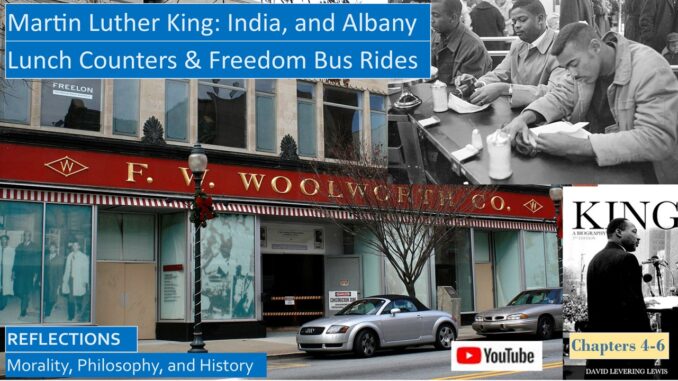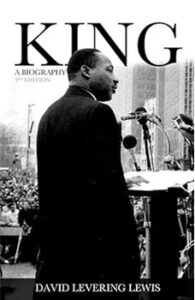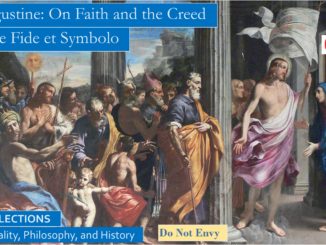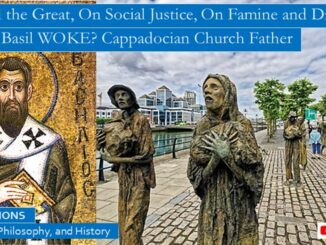
Today we are reflecting on the chapter in David Levering Lewis’ biography of Martin Luther King on his civil rights struggles on the sit-ins desegregating the lunch counters and the Freedom Bus Rides. We reflect on these questions:
Why did Martin Luther King and the other ministers organize the SCLC, or Southern Christian Leadership Conference? How did the SCLC differ from the NAACP?
Why did students initiate the lunch counter protests?
How could the KKK set on fire the Freedom Buses carrying protesting white and black students? Where were the police? Why did the KKK dynamite numerous black churches?
Script for this video, with more Amazon book links: https://www.slideshare.net/slideshows/martin-luther-king-lunch-counters-freedom-riders-and-albany-lewis-biography-chapters-46/265477594
YouTube video for this blog: https://youtu.be/_TLt2fQqL4w
MARTIN LUTHER KING AFTER MONTGOMERY
Martin Luther King was great television. His captivating oratory quickly catapulted him to the forefront of the Civil Rights movement. Like the black leaders in the three preceding generations, Frederick Douglass, Booker T Washington, and WEB Du Bois, Martin Luther King was elevated by the media to iconic status.
The major difference was that Martin Luther King was a newcomer, an upstart. These three previous generations of black leaders became the Civil Rights spokesmen for their race because, in part, there were not as many prominent black leaders who had the education to assume a leadership role. But this was not true after World War II: by then many competent and prominent black Civil Rights leaders had been fighting these battle for years. Although they appreciated the media attention that followed Martin Luther King wherever he went, they often resented him when he would swoop down to usurp their battles to gain civil rights in their localities.
The first-generation black leader was Frederick Douglass, who escaped from slavery in the 1830’s and was a spokesman for the abolitionist movement.
Frederick Douglass Tells Us About His Life as a Slave in his Autobiography
http://www.seekingvirtueandwisdom.com/frederick-douglass-tells-us-about-his-life-as-a-slave-in-his-autobiography/
https://youtu.be/7VkzhyNnuQk
Our biographer David Levering Lewis characterized the black civil rights movement as a struggle between the accommodationists and the activists. Perhaps the first accommodationist position was the second-generation black leader, Booker T Washington, while WEB Du Bois, the third-generation black leader, was an activist.
Tensions Between WEB Du Bois and Booker T Washington, Accommodation or Activism?
https://seekingvirtueandwisdom.com/tensions-between-web-du-bois-and-booker-t-washington/
https://youtu.be/Ntjl4xqQSfw
Booker T Washington argued that blacks could be unified economically while separated socially. In his era, he encouraged blacks to learn the trades in vocational school and had a low opinion of liberal arts education. He promoted the view that blacks would be successful economically by their “industrious labor and economic activity.” His “success would ultimately win the indulgence of the white community.”
Up From Slavery: Autobiography of Booker T Washington
http://www.seekingvirtueandwisdom.com/up-from-slavery-autobiography-of-booker-t-washington/
https://youtu.be/yxDnJ6sBoJc
WEB Du Bois, in contrast, was a proponent of higher education to prepare the top five percent of blacks for their leadership roles to win civil rights for their race. He encouraged “the individual black to actively demonstrate against his degraded status and refuse to accept” segregation. “He must develop his intellectual powers fully to argue his case before his oppressors and inspire fellow blacks to perfect their intellectual capacities.”
WEB Du Bois and the NAACP, Continuing the Fight For Civil Rights
https://seekingvirtueandwisdom.com/web-du-bois-and-the-naacp-continuing-the-fight-for-civil-rights/
https://youtu.be/MNhkq69CIfo
Lewis discusses two other approaches to civil rights. One is the militant approach, first shown in the Nat Turner slave rebellion, the belief that “racial bloodletting would compel” “drastic social change,” which we also discussed in this reflection.
Three Generations of Leading Black Leaders, Frederick Douglass, Booker T Washington, and WEB Du Bois
https://seekingvirtueandwisdom.com/three-generations-of-leading-black-leaders-frederick-douglass-booker-t-washington-and-web-du-bois/
https://youtu.be/DAEg463i-Tc
Another approach is the racial separatism of Marcus Garvey, who sought the “formation of an authentic black culture” and the “wholesale migration of the race to Africa,” this reflection is included in Lewis’ biography of WEB Du Bois. The Black Panther Movement and Malcolm X’s Nation of Islam were movements echoing these themes.
WEB Du Bois and the NAACP, Continuing the Fight For Civil Rights
https://seekingvirtueandwisdom.com/web-du-bois-and-the-naacp-continuing-the-fight-for-civil-rights/
https://youtu.be/MNhkq69CIfo
We first reflected on Martin Luther King’s youth and school years, how his family was involved in both the ministry and civil rights movement of Atlanta, Georgia.
Martin Luther King, Youth and Schooling, Lewis’ Biography Chapters, 1 and 2
https://seekingvirtueandwisdom.com/martin-luther-king-youth-and-schooling-lewis-biography-chapters-1-and-2/
https://youtu.be/_64FMZ6AlEg
Then we reflected on his role in the Montgomery Bus Boycott, sparked by the protest of Rosa Parks, which attracted national media attention and made Martin Luther King an icon of the civil rights movement.
Martin Luther King and Rosa Parks, Montgomery Bus Boycott, Lewis’ Biography, Chapter 3
https://seekingvirtueandwisdom.com/martin-luther-king-and-rosa-parks-montgomery-bus-boycott-lewis-biography-chapter-3/
https://youtu.be/TuiyFycWE-U
FOUNDING THE SCLC, SOUTHERN CHRISTIAN LEADERSHIP CONFERENCE
After the successes and struggles in Montgomery Bus Boycott, there was a regional conference for everyone involved in the civil rights ministry, where they formed the SCLC, or the Southern Christian Leadership Conference. As our biographer Lewis puts it, “Although none doubted the efficacy of the NAACP or Urban League, their deliberations had persuaded the ministers that an organization whose focus would be exclusively Southern, capitalizing on the national treasury of grace accumulated by Martin’s Montgomery triumph, was desperately needed.”
They appointed Martin Luther King as President and Ralph Abernathy as Treasurer of the SCLC. Since this consumed most of his time, Martin soon resigned from his post as minister of Dexter Baptist Church. However, in 1960 he was appointed co-pastor of the Ebenezer Baptist Church, where his father, Martin Luther King Sr, was the lead pastor. During his lifetime, for better or worse, the SCLC was seen as an extension of Martin Luther King’s personality.
Unlike in previous generations, now there would be a multiplicity of national civil rights organizations with differing strategies and focuses, often cooperating, sometimes competing, often with always chaotic and tension filled relationships. The NAACP focused on challenging Jim Crow segregation laws in the courts, the Urban League focused on the gradual integration of blacks into the managerial class, while SCLC focused on activism and protests, pressing for speedier desegregation and social justice, and fighting for black suffrage. To show their willingness to cooperate, both Martin Luther King individually and the SCLC collectively formally joined the NAACP. Sometimes the leadership of the NAACP would object that Martin Luther King was moving too swiftly and aggressively.
One of the first actions of the SCLC was to ask President Eisenhower to deliver a policy speech requesting quicker implementation of the Supreme Court Brown decision to desegregate public schools with all deliberate speed, asking that Vice President Richard Nixon tour the south and support their efforts. This request was ironic, since later Nixon would implement the Southern Strategy to go slow on civil rights, and that would gradually shift the Deep South from being a Democratic stronghold to becoming a Republican stronghold.
The Republican President Eisenhower reluctantly supported various civil rights issues. He dispatched federal troops to enforce the desegregation of the schools in Little Rock, Arkansas. When Governor Orval Faubus opposed the enforcement of the Supreme Court Brown decision, the general in Eisenhower could not permit him to tolerate this insubordination.
Under Eisenhower’s administration, a tame Civil Rights Act was passed in 1957, “the first of its kind since 1875.” As Lewis writes, this “created a Civil Rights Commission empowered to gather information on voting rights violations and authorized the quiescent Justice Department to initiate injunctive relief in cases of proven voting irregularities.” This legislation included stiff punishments for “individuals crossing state lines to foment violence,” which was a Southern tactic to oppose civil rights protests.
Martin Luther King was vigorously campaigning for voting rights. In his first national address, he proclaimed, “Give us the ballot. Give us the ballot and we will no longer have to worry the federal government about our basic rights.” “Give us the ballot and we will fill the legislature with men of goodwill. Give us the ballot and we will get the people judges who love mercy. Give us the ballot and we will quietly, lawfully, and nonviolently, without rancor or bitterness, implement” the US Supreme Court Brown decision. Ensuring that blacks have the right to vote was the key civil rights objective in the Reconstruction Era after the Civil War.
Refuting the Lost Cause: Black Reconstruction by WEB Du Bois
http://www.seekingvirtueandwisdom.com/refuting-the-lost-cause-black-reconstruction-by-web-dubois/
https://youtu.be/JeRCM4PAqPk
Post-Civil War Reconstruction and Redemption History, Yale Lecture Notes
http://www.seekingvirtueandwisdom.com/post-civil-war-reconstruction-and-redemption-history-yale-lecture-notes/
https://youtu.be/f5nPNnvDBCY
The movement took a breather after the Montgomery struggle. During this time Martin Luther King attended the 1957 independence celebrations of the black English Commonwealth African nation of Ghana. Here he conferred with Richard Nixon, who also attended. Martin was also invited to consult with the Prime Minister of India, which had also recently gained independence from Great Britain with nonviolent means as practiced by Gandhi.
At this time, Martin Luther King proclaimed: “It is my hope that as the Negro plunges deeper into the quest for freedom and justice he will plunge even deeper into the philosophy of nonviolence. The Negro all over the South must” “say to his white brother: ‘We will match your capacity to inflict suffering with our capacity to endure suffering. We will meet your physical force with soul force. We will not hate you, but we will not obey your evil laws. We will soon wear you down by pure capacity to suffer.’” He compared the nonviolent struggle with the Agape love of the New Testament.[1]
LUNCH COUNTER PROTESTS IN THE DEEP SOUTH
In that era, blacks were not permitted eat lunch with white customers at lunch counters in department and variety stores. In 1960 college students, black and white, protested in North Carolina by sitting at lunch counters, and if they were not served, they would simply stay to protest. These sit-ins spread to Tennessee, home of the leading black Fisk University, led by future civil rights leaders Marion Barry and John Lewis.
Then the lunch counter sit-ins, planned by the future civil rights leader Julian Bond, Martin Luther King, and others, were organized in Atlanta, Georgia. In total, these sit-ins spread to fourteen cities in five Southern states. To organize the movement nationally, the SCLC provided the initial funding to found the independent SNCC, or Student Nonviolent Coordinating Committee. There were about two hundred delegates to their first national meeting, including black and white students, members of the SCLC and CORE. CORE was a civil rights organization founded with both black and white members in 1942.
At the conference, SNCC issued a student manifesto, An Appeal for Human Rights, that demanded “community action in education, housing, jobs, voting, law enforcement, hospitals, and entertainment facilities, including restaurants, movies, and concerts.” Martin Luther King’s keynote speech recommended a program of selective buying and boycotts of businesses to encourage desegregation and civil rights, and the “formation of an army of volunteers prepared to accept prison sentences in lieu of fines and bail.”
Martin Luther King emphasized that nonviolence was central to the struggle. He proclaimed, “there is another element that makes our resistance and nonviolence truly meaningful. That element is reconciliation.” “The tactics of nonviolence without the spirit of nonviolence may become a new kind of violence.”
After the year-end 1960 conference of the SNCC, where Martin was the keynote speaker, both he and thirty-five other members, mostly students, were arrested for trespassing for their Atlanta lunch counter sit-ins earlier in the year. Although they refused bond, the mayor of Atlanta arranged a two-month truce, promising their demands would be considered, releasing them from jail.
Martin had been arrested for a minor traffic violation previously, and it was now claimed that his participation in the lunch counter protests was a violation of his bail agreement. There were concerns that he would be lynched when transported to the jail, protests swamped the Eisenhower administration. His opponent for the Presidency, John F Kennedy, interceded on behalf of Martin, who was granted bail. This intervention may have been a decisive element is his winning the 1960 Presidential Election.
FREEDOM RIDERS AND DESEGREGATION OF INTERSTATE BUSES
CORE had been fighting to end segregation in interstate travel since 1947, when it had sponsored a two-week effort when black protestors attempted to ride the segregated interstate buses, which resulted in both arrests and jail time. In 1961, they revived this protest, sponsoring Freedom Rides by black and white students and activists riding interstate buses. Although CORE was the primary organizer, Martin Luther King and the SCLC participated in the protests. Due to his organizational responsibilities, Martin did not directly participate in the demonstrations, which drew criticism, but his fellow officer Ralph Abernathy did ride the Freedom Buses.
The first two buses carrying the Freedom black and white protestors boarded two buses in Washington DC, bound for Alabama. One bus was set on fire by angry whites. When the other bus reached Birmingham, Alabama, the Freedom Riders were beaten severely by white thugs while Bull Conner and the police looked on, and while the television cameras rolled. The bus companies refused to carry them further to their destination.
When another group of Freedom Riders departing from Tennessee arrived in Montgomery, Alabama, they were initially threatened by a mob of three hundred angry whites, which swelled to nearly a thousand. John Lewis of the SNCC, a future congressman, a leading journalist, and a special White House representative were among those injured in the ensuing violence. While the mobs rioted, the television cameras continued to roll, and public opinion shifted.
Immediately, Martin rushed to Montgomery, as did seven hundred marshals sent by Attorney General Robert Kennedy and hundreds of Alabama National Guardsmen sent by the governor. Martin spoke eloquently at a local church, “The law may not be able to make a man love me, but it can keep him from lynching me.” This was not true in the early years of WEB Du Bois and during the lifetime of Booker T Washington, when lynching was rampant.
Ida B Wells, Journalist, Brave Woman, and Anti-Lynching Activist
http://www.seekingvirtueandwisdom.com/ida-b-wells-journalist-brave-woman-and-anti-lynching-crusader/
https://youtu.be/sLDHs0AigvY
The SCLC leadership thought that the NAACP moved too slow and was too conciliatory, and the SNCC leadership thought the same of the SCLC. But in September 1961, the ICC, or Interstate Commerce Commission, abolished segregation aboard buses and terminal facilities, including bus stations.[2]
WAS THE STRUGGLE IN ALBANY A SUCCESS, OR A FAILURE?
The Freedom Rides and other protests were continued in Albany, Georgia. Our biographer Lewis reports that many at the time thought that the inconclusiveness of these protests was a failure, that they weren’t sufficiently focused, that there was insufficient coordination between the competing civil rights organizations.
But they were a success, since by being involved, Martin Luther King attracted media coverage. Success is grounded in persistence, if you do not give up, you succeed. And they learned from their struggles and tactical errors. The problem was that the media coverage was lacking a truly villainous foe in Albany.
Police Chief Pritchett announced, “We, the duly constituted authorities and citizens of this city, met nonviolence with nonviolence and we are, indeed, proud of the outcome.” “We killed them with kindness.” This was a foe that Martin had not encountered, he was unsure whether to be hostile or conciliatory.
The black and white Freedom Riders, in protest, sat in the white section of the bus arriving in Albany. Several hundred protestors welcomed their arrival, and they insisted on sitting in the whites-only section of the bus terminal. Pritchett snapped and threw them in jail, which sparked several hundred activists to protest at city hall, leading to the arrest of five hundred protestors. Martin Luther King was also jailed when he protested, declining bail, and the number of arrests swelled to seven hundred. Although jail conditions were harsh and there was abuse, the arresting police officers behaved with restraint and civility, which did not make for good television.
In December, a truce was called, Martin accepted bail, and all demonstrators were released on bail. The ruling of the ICC took effect the previous month, ending segregation in the bus terminals. But libraries and cinemas remained segregated. The city agreed to discuss civil rights matters the following January after the city government was installed, and mass demonstrations would end until then. This compromise was a tactical defeat for the movement.
A boycott of white business was announced, but it was not effective because the blacks had limited purchasing power in Albany. A city bus boycott was also announced, which eventually bankrupted the bus company, ending the city bus service altogether. Martin announced a campaign of civil disobedience, and that summer protesting blacks sought service at lunch counters, movies, libraries, parks, bowling alleys, and attempted to attend white church services, the final insult.
There were many arrests. A pregnant Mrs King was kicked unconscious when she attempted to bring food to friends being held at the prison camp. In response, two thousand young blacks rioted, battling the police with bricks and bottles. The governor called up twelve thousand national guardsmen to quell the disturbances. Following Gandhi’s example, Martin responded to this outbreak of violence by curtailing the protests for a week to cool the temperature, which the SNCC leaders objected to. Then Martin once again joined the protests and was arrested, and then subsequently was released.
The Ku Klux Klan then dynamited four black churches in nearby towns, destroying or heavily damaging them. Three of these churches were rebuilt using funds from the AFL-CIO and northern liberals, but racial conditions deteriorated. Public parks, public pools, and libraries were either closed down or privatized to avoid desegregation. One commentator observed that “Albany was successful only if the goal was to go to jail.”[3]
But in his next battle in Birmingham, Alabama would make for better television because Martin Luther King faced an implacable and foolishly violent antagonist, the infamous Jim Crow Sheriff, Bull O’Conner, whom we just met in the Freedom Riders protests.
YT
After the Birmingham struggle, there was the March on Washington where Martin Luther King delivered his famous “I Have a Dream” speech at the Reflecting Pool in Washington, DC. After that, there was the bloody march on Selma, his fight for more equitable housing in Chicago, and finally, when his life was cut short by his assassination in Memphis.
yt
DISCUSSING THE SOURCES
The author, David Levering Lewis, was planning to write the biography of Martin Luther King when he was assassinated. It was initially published sixteen months later and quickly became the classic biography of this Civil Rights icon. We also supplemented his account with the Wikipedia articles for CORE. We discussed his biography in greater depth in our reflection on his youth and school years.
Martin Luther King, Youth and Schooling, Lewis’ Biography Chapters, 1 and 2
https://seekingvirtueandwisdom.com/martin-luther-king-youth-and-schooling-lewis-biography-chapters-1-and-2/
https://youtu.be/_64FMZ6AlEg
The professor in our Yale Lecture Notes on Civil Rights also discusses the Emmitt Till lynching, the Little Rock school integration efforts, and the Freedom Rider protesters seeking to desegregate the interstate buses, and other struggles we will soon study, in the context of other protests in the Civil Rights era of the Sixties.
American Civil Rights History: Yale Lecture Notes
http://www.seekingvirtueandwisdom.com/american-civil-rights-history-yale-lecture-notes/
Civil Rights Era, Sixties and Beyond: Yale Lecture Notes
https://youtu.be/GQesHoV5IdI
Lewis also wrote the definitive biography for WEB Du Bois.
[1] David Levering Lewis, KING, a Biography (Chicago, Illinois, University of Illinois Press, 2013, 1970), Chapter 4, pp. 85-111.
[2] David Levering Lewis, KING, a Biography, Chapter 5, pp. 112-139 and https://en.wikipedia.org/wiki/Congress_of_Racial_Equality .
[3] David Levering Lewis, KING, a Biography, Chapter 6, pp. 140-170.





3 Trackbacks / Pingbacks